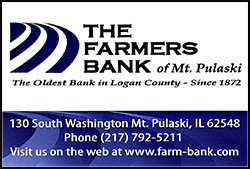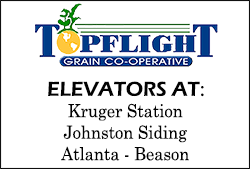|
 USDA announced that in the first month of the application
period, the Farm Service Agency (FSA) approved more than $7
billion in payments to producers in the second round of the
Coronavirus Food Assistance Program. CFAP 2 provides
agricultural producers with financial assistance to help absorb
some of the increased marketing costs associated with the
COVID-19 pandemic. USDA announced that in the first month of the application
period, the Farm Service Agency (FSA) approved more than $7
billion in payments to producers in the second round of the
Coronavirus Food Assistance Program. CFAP 2 provides
agricultural producers with financial assistance to help absorb
some of the increased marketing costs associated with the
COVID-19 pandemic.
Since CFAP 2 enrollment began on September 21, 2020, FSA has
approved more than 443,000 applications. The top five states for
payments are Iowa, Nebraska, Minnesota, Illinois and Kansas.
USDA has released a data dashboard on application progress and
program payments and will release further updates each Monday at
2:00 p.m. ET. The report can be viewed at farmers.gov/cfap.

Through CFAP 2, USDA is making available up to $14 billion for
agricultural producers who continue to face market disruptions
and associated costs because of COVID-19. CFAP 2 is a separate
program from the first iteration of CFAP (CFAP 1). Farmers and
ranchers who participated in CFAP 1 will not be automatically
enrolled and must complete a new application for CFAP 2. FSA
will accept CFAP 2 applications through December 11, 2020.
Eligible Commodities
CFAP 2 supports eligible producers of row crops, livestock,
specialty crops, dairy, aquaculture, and many other commodities,
including many that were ineligible for CFAP 1. FSA’s CFAP 2
Eligible Commodities Finder makes finding eligible commodities
and payment rates simple. Access this tool and other resources
at farmers.gov/cfap.
Getting Help from FSA
New customers seeking one-on-one support with the CFAP 2
application process can call 877-508-8364 to speak directly with
a USDA employee ready to offer general assistance. This is a
recommended first step before a producer engages the team at the
FSA county office at their local USDA Service Center.
FSA offers multiple options for producers to apply for CFAP 2.
Producers with an eAuthentication account can apply online
through the CFAP 2 Application Portal. Also available is a
payment calculator and application generator that is an Excel
workbook that allows producers to input information specific to
their operation to determine estimated payments and populate the
application form, which can be printed, signed, and submitted to
the local FSA office. Producers can also download the CFAP 2
application and other eligibility forms from farmers.gov/cfap.

Producers of acreage-based commodities will use acreage and
yield information provided by FSA through the annual acreage
reporting process. Producers have the option to complete their
application by working directly with their local FSA staff or
online through the CFAP 2 Application Portal.
CFAP 2 is not a loan program, and there is no cost to apply.
More Information
To find the latest information on CFAP 2, visit farmers.gov/CFAP
or call 877-508-8364.
Dairy Margin Coverage Program Enrollment for 2021 Opened
October 13
The U.S. Department of Agriculture (USDA) began accepting
applications for the Dairy Margin Coverage (DMC) program on
Tuesday, October 13, 2020 for 2021 enrollment.
Signup runs through December 11, 2020. DMC is a voluntary risk
management program that offers protection to dairy producers
when the difference between the all-milk price and the average
feed price (the margin) falls below a certain dollar amount
selected by the producer. DMC payments triggered for seven
months in 2019 and three months so far in 2020. More than 23,000
operations enrolled in DMC in 2019, and more than 13,000 in
2020.
To determine the appropriate level of coverage for a specific
dairy operation, producers can utilize the recently updated
online dairy decision tool. The decision tool is designed to
assist producers with calculating total premium costs and
administrative fees associated with participation in DMC. An
informational video is available, too.
Improvements to the decision tool, made in cooperation with
representatives from the University of Minnesota and University
of Wisconsin, include historical analysis that illustrates what
DMC indemnity payments might have been had the program been
available over the previous two decades. The analysis indicates
that over the course of time, DMC payments made to producers
exceed premiums paid. These decision tool enhancements provide a
more comprehensive decision support experience for producers
considering DMC.

In addition to DMC, USDA offers a variety of programs that have
helped dairy producers, including insurance, disaster
assistance, and conservation programs. Most recently, the
Coronavirus Food Assistance Program 1 provided $1.75 billion in
direct relief to dairy producers who faced price declines and
additional marketing costs due to COVID-19 in early 2020. Now,
signup is underway for the Coronavirus Food Assistance Program
2, which provides another round of assistance for dairy
producers and many other eligible producers.
For more information, visit farmers.gov DMC webpage, or contact
your local USDA Service Center. To locate your local FSA office,
visit farmers.gov/service-center-locator.
All USDA Service Centers are open for business, including some
that are open to visitors to conduct business in person by
appointment only. All Service Center visitors wishing to conduct
business with the FSA, Natural Resources Conservation Service,
or any other Service Center agency should call ahead and
schedule an appointment. Service Centers that are open for
appointments will pre-screen visitors based on health concerns
or recent travel, and visitors must adhere to social distancing
guidelines. Visitors are required to wear a face covering during
their appointment. Field work will continue with appropriate
social distancing. Our program delivery staff will be in the
office, and they will be working with our producers in office,
by phone, and using online tools. More information can be found
at farmers.gov/coronavirus.
FSA Encourages Farmers and Ranchers to Vote in County
Committee Elections
The 2020 Farm Service Agency County Committee Elections began
when ballots were mailed to eligible voters the week of November
2, 2020. The deadline to return ballots to local FSA offices, or
to be postmarked, is December 7, 2020.
County committee members are an important component of the
operations of FSA and provide a link between the agricultural
community and USDA. Farmers and ranchers elected to county
committees help deliver FSA programs at the local level,
applying their knowledge and judgment to make decisions on
commodity price support programs, conservation programs,
incentive indemnity and disaster programs for some commodities,
emergency programs and eligibility. FSA committees operate
within official regulations designed to carry out federal laws.
To be an eligible voter, farmers and ranchers must participate
or cooperate in an FSA program. A person who is not of legal
voting age but supervises and conducts the farming operations of
an entire farm, may also be eligible to vote.
Eligible voters in the local administrative area(s) conducting
an election this year who do not receive a ballot can obtain one
from their local USDA Service Center.
Newly elected committee members will take office January 1, 2021
FSA is Accepting CRP Continuous Enrollment
Offers
The Farm Service Agency (FSA) is accepting
offers for specific conservation practices under the
Conservation Reserve Program (CRP) Continuous Signup.
In exchange for a yearly rental payment, farmers enrolled in the
program agree to remove environmentally sensitive land from
agricultural production and to plant species that will improve
environmental health and quality. The program’s long-term goal
is to re-establish valuable land cover to improve water quality,
prevent soil erosion, and reduce loss of wildlife habitat.
Contracts for land enrolled in CRP are 10-15 years in length.
Under continuous CRP signup, environmentally sensitive land
devoted to certain conservation practices can be enrolled in CRP
at any time. Offers for continuous enrollment are not subject to
competitive bidding during specific periods. Instead they are
automatically accepted provided the land and producer meet
certain eligibility requirements and the enrollment levels do
not exceed the statutory cap.
For more information, including a list of acceptable practices,
contact your local County USDA Service Center or visit
fsa.usda.gov/crp.
USDA Announces Increased Subsidies and Other
Improvements to the Livestock Risk Protection Insurance Program
U.S. Department of Agriculture’s (USDA) Risk
Management Agency (RMA) is increasing premium subsidies and will
make other improvements to the Livestock Risk Protection (LRP)
plan of insurance for feeder cattle, fed cattle, and swine
starting with the 2021 crop year. The increased premium subsidy
is retroactive to the beginning of the 2021 crop year and is
based on the coverage selected by the livestock producer. RMA
will implement the other improvements later this year.
USDA encourages livestock producers to contact their insurance
agent to take advantage of these improvements. These changes
will not only make LRP more affordable for producers, but also
will provide them with better coverage.
Other improvements to be implemented include:
-
Increasing livestock head limits for feeder and fed cattle
to 6,000 head per endorsement/12,000 head annually, and
swine to 40,0000 head per endorsement/150,000 head annually
-
Modifying the requirement to own insured livestock until the
last 60 days of the endorsement
-
Increasing the endorsement lengths for swine up to 52 weeks
-
Creating new feeder cattle and swine types to allow for
unborn livestock to be insured
For more information on the LRP program, please
see the RMA website.
RMA is authorizing additional flexibilities due to coronavirus
while continuing to support producers, working through Approved
Insurance Providers (AIPs) to deliver services, including
processing policies, claims, and agreements. RMA staff are
working with AIPs and other customers by phone, mail, and
electronically to continue supporting crop insurance coverage
for producers. Farmers with crop insurance questions or needs
should continue to contact their insurance agents about
conducting business remotely (by telephone or email). More
information can be found at farmers.gov/coronavirus.
Crop insurance is sold and delivered solely through private
insurance agents. A list of insurance agents is available online
using the RMA Agent Locator. Learn more about crop insurance and
the modern farm safety net at rma.usda.gov.
Farmers Encouraged to Keep the Stubble
During No-Till November
The Natural Resources Conservation Service (NRCS)
is encouraging Illinois farmers to “keep the stubble” on their
harvested crop fields and improve soil health during No-Till
November. First launched in 2017, the NRCS project is mirrored
after the national cancer awareness ‘No Shave November’ campaign
that encourages people not to shave during the entire month. The
NRCS campaign encourages farmers to keep tillage equipment in
their machine sheds this fall and keep the crop stubble on their
fields. The campaign has reached more than 1.5 million people
through Twitter and local media since 2017.
According to Ivan Dozier, Illinois NRCS State Conservationist,
no-till farming is a cornerstone soil health conservation
practice, which also promotes water quality while saving farmers
time and money. One of the first soil health principles is ‘do
not disturb.’ Dozier supports this campaign as a fun way to
remind farmers about the important relationship between tillage
and soil health. Improving soil health increases soil biological
activity, which provides erosion control, nutrient benefits, and
can simulate tillage. Supporting the campaign’s message is
Champaign County no-till farmer and former President of the
Association of Illinois Soil and Water Conservation Districts
Steve Stierwalt. According to Stierwalt, Illinois has a lot of
great conservation farmers in Illinois who are using no-till and
working with cover crops and he’s thankful for all they’re doing
to impact our natural resources. Stierwalt warns, however, that
we need more farmers to embrace these new and profitable ways of
production agriculture. No-till works for Stierwalt and they’ll
work for you too.
Join Ivan, Steve, and so many others who are making a difference
by keeping the stubble on the ground this winter. Dozier
encourages farmers to keep your fields covered. Your soil—and
all those earthworms--will thank you next spring! For more
information on soil health and no-till, visit
https://www.nrcs.usda.gov/
wps/portal/nrcs/il/soils/health/ . And keep an eye on IL
NRCS’ twitter account to get all the stories, notifications, and
helpful information
https://twitter.com/NRCS_Illinois
Disaster Set-Aside (DSA) Program for Farm
Loan Borrowers
Farm Service Agency (FSA) borrowers with farms
located in designated primary or contiguous disaster areas who
are unable to make their scheduled FSA loan payments should
consider the Disaster Set-Aside (DSA) program.
DSA is available to producers who suffered losses as a result of
a natural disaster and relieves immediate and temporary
financial stress. FSA is authorized to consider setting aside
the portion of a payment/s needed for the operation to continue
on a viable scale.
Borrowers must have at least two years left on the term of their
loan in order to qualify.
Borrowers have eight months from the date of the disaster
designation to submit a complete application. The application
must include a written request for DSA signed by all parties
liable for the debt along with production records and financial
history for the operating year in which the disaster occurred.
FSA may request additional information from the borrower in
order to determine eligibility.
All farm loans must be current or less than 90 days past due at
the time the DSA application is complete. Borrowers may not set
aside more than one installment on each loan.
The amount set-aside, including interest accrued on the
principal portion of the set-aside, is due on or before the
final due date of the loan.
For more information, contact your local County USDA Service
Center or visit fsa.usda.gov.
Making Farm Reconstitutions
When changes in farm ownership or operation
take place, a farm reconstitution is necessary. The
reconstitution — or recon — is the process of combining or
dividing farms or tracts of land based on the farming operation.
To be effective for the current Fiscal Year (FY), farm
combinations and farm divisions must be requested by August 1 of
the FY for farms subject to the Agriculture Risk Coverage (ARC)
and Price Loss Coverage (PLC) program. A reconstitution is
considered to be requested when all of the required signatures
are on FSA-155 and all other applicable documentation, such as
proof of ownership, is submitted.
Total Conservation Reserve Program (CRP) and non-ARC/PLC farms
may be reconstituted at any time.
[to top of second column] |
 The following are the different methods used when doing a farm
recon:
Estate Method — the division of bases, allotments and
quotas for a parent farm among heirs in settling an estate
Designation of Landowner Method — may be used when (1)
part of a farm is sold or ownership is transferred; (2) an
entire farm is sold to two or more persons; (3) farm ownership
is transferred to two or more persons; (4) part of a tract is
sold or ownership is transferred; (5) a tract is sold to two or
more persons; or (6) tract ownership is transferred to two or
more persons. In order to use this method, the land sold must
have been owned for at least three years, or a waiver granted,
and the buyer and seller must sign a Memorandum of Understanding
DCP Cropland Method — the division of bases in the same
proportion that the DCP cropland for each resulting tract
relates to the DCP cropland on the parent tract
Default Method — the division of bases for a parent farm
with each tract maintaining the bases attributed to the tract
level when the reconstitution is initiated in the system.
For more information and assistance, please
contact your local USDA service center. To find your local USDA
service center, visit farmers.gov/service-center-locator.

USDA Seeks New Partnerships to Safeguard,
Restore Wetland Ecosystems
The United States Department of Agriculture (USDA)
recently announced up to $30 million is available in technical and
financial assistance through the Wetland Reserve Enhancement
Partnership (WREP) to help conservation partners protect and restore
critical wetlands on agricultural lands in Illinois. Restored
wetlands help improve water quality downstream, enhance wildlife
habitat, reduce impacts from flooding, and provide recreational
benefits.
These partnerships enhance the locally driven process to better
address critical wetland functions that progress beyond localities.
WREP works with other NRCS landscape-level conservation efforts to
coordinate the delivery of conservation assistance to producers in
targeted areas that yield the most impacts for accelerated benefits
nationally and regionally. Continuing to leverage these partnerships
helps NRCS continue the important work with producers to help
recover the health of wetland ecosystems on working lands.
Eligible conservation partners in Illinois will work through WREP to
voluntarily execute high priority wetland protection, restoration,
and enhancement activities on eligible agriculture lands. WREP
enables effective integration of wetland restoration on working
agricultural landscapes, providing meaningful benefits to farmers
who enroll in the program and to the communities where the wetlands
exist.
NRCS will review partners’ project proposals and evaluate priority
resource concerns, objectives, costs, and expected outcomes for each
project and rank proposals based on the criteria set forth in the
ranking worksheet on the WREP webpage. Proposals should be emailed
to NRCS State Conservationist Ivan Dozier at ivan.dozier@usda.gov by
November 30, 2020.

Wetland Reserve Easements enable landowners to successfully reduce
impacts from flooding, recharge groundwater, enhance and protect
wildlife habitat, and provide outdoor recreational and educational
opportunities. Healthy wetlands, including those protected and
restored through WREP, contribute to USDA’s Agriculture Innovation
Agenda of reducing the environmental footprint of U.S. agriculture
in half by 2050. Visit the WREP webpage for more information on the
workshop or this program opportunity.
Cover Crop Guidelines
The Farm Service Agency (FSA), Natural Resources
Conservation Service (NRCS) and Risk Management Agency (RMA) worked
together to develop consistent, simple and a flexible policy for
cover crop practices.
Cover crops, such as grasses, legumes and forbs, can be planted:
with no subsequent crop planted, before a subsequent crop, after
prevented planting acreage, after a planted crop, or into a standing
crop.
Termination:
The cover crop termination guidelines provide the timeline for
terminating cover crops, are based on zones and apply to
non-irrigated cropland. To view the zones and additional guidelines
visit nrcs.usda.gov/wps/portal/nrcs/main/
national/landuse/crops/ and click “Cover Crop Termination
Guidelines.”
The cover crop may be terminated by natural causes, such as frost,
or intentionally terminated through chemical application, crimping,
rolling, tillage or cutting. A cover crop managed and terminated
according to NRCS Cover Crop Termination Guidelines is not
considered a crop for crop insurance purposes.
Reporting:
The intended use of cover only will be used to report cover crops.
This includes crops
that were terminated by tillage and reported with an intended use
code of green manure. An FSA policy change will allow cover crops to
be hayed and grazed. Program eligibility for the cover crop that is
being hayed or grazed will be determined by each specific program.
If the crop reported as cover only is harvested for any use other
than forage or grazing and is not terminated properly, then that
crop will no longer be considered a cover crop.

Crops reported with an intended use of cover only will not count
toward the total cropland on the farm. In these situations, a
subsequent crop will be reported to account for all cropland on the
farm.
the coverage levels of between 50 and 65 percent of expected
production. Buy-up levels of NAP coverage are available if the
producer can show at least one year of previously successfully
growing the crop for which coverage is being requested. NAP basic
coverage is available at 55 percent of the average market price for
crop losses that exceed 50 percent of expected production.
For all coverage levels, the NAP service fee is the lesser of $325
per crop or $825 per producer per county, not to exceed a total of
$1,950 for a producer with farming interests in multiple counties.
Beginning, underserved, veterans and limited resource farmers are
now eligible for free catastrophic level coverage.
Deadlines for coverage vary by state and crop. contact your local
County USDA Service Center or visit fsa.usda.gov.
Federal crop insurance coverage is sold and delivered solely through
private insurance agents. Agent lists are available at all USDA
Service Centers or at USDA’s online Agent Locator. You can use the
USDA Cost Estimator to predict insurance premium costs.
Farm Storage Facility Loans
FSA’s Farm Storage Facility Loan (FSFL) program
provides low-interest financing to producers to build or upgrade
storage facilities and to purchase portable (new or used)
structures, equipment and storage and handling trucks.
The low-interest funds can be used to build or upgrade permanent
facilities to store commodities. Eligible commodities include corn,
grain sorghum, rice, soybeans, oats, peanuts, wheat, barley, minor
oilseeds harvested as whole grain, pulse crops (lentils, chickpeas
and dry peas), hay, honey, renewable biomass, fruits, nuts and
vegetables for cold storage facilities, floriculture, hops, maple
sap, rye, milk, cheese, butter, yogurt, meat and poultry
(unprocessed), eggs, and aquaculture (excluding systems that
maintain live animals through uptake and discharge of water).
Qualified facilities include grain bins, hay barns and cold storage
facilities for eligible commodities.
Loans up to $50,000 can be secured by a promissory note/security
agreement and loans between $50,000 and $100,000 may require
additional security. Loans exceeding $100,000 require additional
security.
Producers do not need to demonstrate the lack of commercial credit
availability to apply. The loans are designed to assist a diverse
range of farming operations, including small and mid-sized
businesses, new farmers, operations supplying local food and farmers
markets, non-traditional farm products, and underserved producers.
To learn more about the FSA Farm Storage Facility Loan, visit
www.
fsa.usda.gov/pricesupport
or contact your local FSA county office. To find your local FSA
county office, visit
http://offices.usda.gov.
USDA Fruit, Vegetable and Wild Rice Planting
Rules Unchanged in 2018 Farm Bill
Fruit, vegetable and wild rice producers will
continue to follow the same rules for certain Farm Service Agency
(FSA) programs.
If you intend to participate in the Agriculture Risk Coverage (ARC)
or Price Loss Coverage (PLC) programs, you are subject to an
acre-for-acre payment reduction when fruits and nuts, vegetables or
wild rice are planted on payment acres of a farm. Payment reductions
do not apply to mung beans, dry peas, lentils or chickpeas. Planting
fruits, vegetables or wild rice on acres not considered payment
acres will not result in a payment reduction. Farms that are
eligible to participate in ARC/PLC but are not enrolled for a
particular year may plant unlimited fruits, vegetables and wild rice
for that year but will not receive ARC/PLC payments. Eligibility for
succeeding years is not affected.
Planting and harvesting fruits, vegetables and wild rice on ARC/PLC
acreage is subject to the acre-for-acre payment reduction when those
crops are planted on more than 15 percent of the base acres of an
ARC enrolled farm using the county coverage or PLC, or more than 35
percent of the base acres of an ARC enrolled farm using the
individual coverage.
Fruits, vegetables and wild rice that are planted in a
double-cropping practice will not cause a payment reduction if the
farm is in a double-cropping region as designated by the USDA’s
Commodity Credit Corporation.
USDA Awards Nearly $500K to Support L Wetland
Mitigation Banking
USDA’s Natural Resources Conservation Service (NRCS)
announced awarded $498,010 for a new wetland mitigation banking
project in Illinois through the Wetland Mitigation Banking Program.
This program helps conservation partners develop and/or establish
mitigation banks to help agricultural producers maintain eligibility
for USDA programs. According to Ivan Dozier, State Conservationist,
these banks will provide agriculture producers a streamlined
mitigation option to remain compliant for USDA Farm Bill programs
while maintaining wetlands to support functions and environmental
values. Healthy wetlands help filter water, sequester carbon, curb
soil loss, and provide habitat for wildlife.
The key partner in the Illinois effort is Magnolia Land Partners,
LLC, who will establish two agricultural mitigation bank sites
totaling 60 acres. Illinois NRCS will provide $498,010 in funding
and Magnolia Partners will contribute $252,000. These sites will be
added under Magnolia’s NRCS approved statewide agricultural
mitigation banking instrument. Magnolia will coordinate site
locations with farm groups.
Mitigation banks create credits through restoration, creation, or
enhancement of wetlands to compensate for impacts on ecosystems in
developing communities. Establishing these banks serves Ag producers
in more flexible ways. According to Dozier, having Magnolia
facilitate and manage all the details for landowners is helpful in
what can be a complex legal process. NRCS leadership will farmers
posted on the site locations and track progress and long-term
benefits for the projects.
Producers seeking benefits through USDA programs must comply with
wetland provisions by avoiding impact on wetlands. In situations
where avoidance or on-site mitigation is challenging, the Farm Bill
offers participants options to mitigate activities off-site through
the purchase of mitigation banking credits.
This competitive grant program helps states, local governments, and
other qualified partners develop wetland mitigation banks to assist
agricultural producers with meeting wetland conservation compliance
requirements to remain eligible for USDA programs. Nationally, USDA
will award $5 million for eight wetland mitigation banking projects
nationwide. For project descriptions and more information, visit the
Wetland Mitigation Banking Program webpage.
Maintaining the Quality of Farm-Stored Loan
Grain
Bins are ideally designed to hold a level volume of
grain. When bins are overfilled and grain is heaped up, airflow is
hindered and the chance of spoilage increases.
Producers who take out marketing assistance loans and use the
farm-stored grain as collateral should remember that they are
responsible for maintaining the quality of the grain through the
term of the loan.
Unauthorized Disposition of Grain
If loan grain has been disposed of through feeding,
selling or any other form of disposal without prior written
authorization from the county office staff, it is considered
unauthorized disposition. The financial penalties for unauthorized
dispositions are severe and a producer’s name will be placed on a
loan violation list for a two-year period. Always call before you
haul any grain under loan.
November Interest Rates and Important Dates
_small.png)
Illinois Farm Service Agency
3500 Wabash Ave.
Springfield, Illinois 62711
Phone: 217-241-6600 ext. 2
Fax: 855-800-1760
www.fsa.usda.gov/il
State Executive Director:
William J. Graff
State Committee:
James Reed-Chairperson
Melanie DeSutter-Member
Kirk Liefer-Member
George Obernagel III-Member
Troy Uphoff-Member
Administrative Officer:
Dan Puccetti
Division Chiefs:
Vicki Donaldson
John Gehrke
Wendy Mueller
Randy Tillman
To find contact information for your local office go to
www.fsa.usda.gov/il
Check out https://www.farmers.gov/ for information about ALL the
programs available through your local USDA Service Center FSA and
NRCS offices, including county office locations, agriculture
statistics, loan interest rates and much more!
Learn about Risk Management Agency's crop insurance programs at
https://cropinsurance101.org/ |